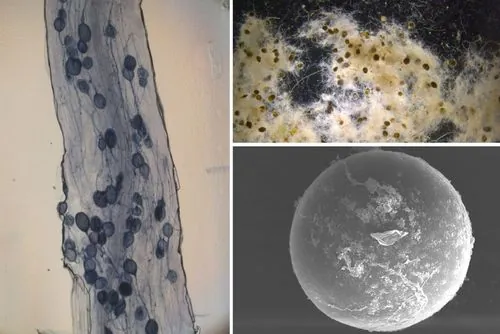
Unlocking Nature's Secret: The Extraordinary Cooperation Between Plants, Fungi, and Bacteria
2025-04-15
Author: William
A Timeless Partnership: Plants and Fungi Unite
For centuries, plants and arbuscular mycorrhizal fungi have thrived together in an incredible symbiotic relationship. These remarkable fungi colonize plant roots, aiding them in nutrient absorption, while plants generously provide the carbon required for fungal growth. According to Mohamed Hijri, a professor at Université de Montréal, these fungi, known as biotrophs, depend entirely on their partnership with plants to obtain necessary nutrients.
The Expanding Network Beneath Our Feet
Nestled within plant roots, these fungi form intricate structures known as arbuscules, allowing them to interact closely with their plant hosts. While many plants can survive without mycorrhizal fungi, the vast networks of white filaments, or extraracinar mycelium, significantly enhance their ability to absorb water and nutrients from the soil. PhD student Zakaria Lahrach emphasizes that these fungi act as extensions of plant roots, effectively exploring the soil for vital resources.
The Hidden Dance with Bacteria
However, the intrigue doesn’t end there! Emerging research reveals that fungi's role extends beyond their partnership with plants; they also engage in a complex interplay with soil bacteria. Fascinatingly, these fungi release some of the carbon they consume back into the soil, attracting bacteria that break down organic matter to release essential nutrients for plants. This crucial interaction not only supports plant health but also aids in carbon sequestration, offering a glimmer of hope for climate change mitigation.
Groundbreaking Research and Discoveries
For his PhD research, Lahrach set out to investigate how arbuscular mycorrhizal fungi attract soil bacteria and enhance phosphate availability for plants. Phosphate is vital for plant growth and development, and specific bacteria in the soil facilitate its solubilization. After two years of diligent experimentation, Lahrach's findings were published in the journal Environmental Microbiome last October.
Exploring Fungal Species and their Bacterial Impact
In his research, Lahrach focused on three fungal species: Rhizophagus irregularis, Rhizophagus clarus, and Rhizophagus cerebriforme, to study their ability to recruit bacteria. Investigating the impact of adding external bacterial communities revealed intriguing results. Remarkably, the enhancement of plant growth, shown through increased biomass and chlorophyll concentration, varied among the fungal species, indicating a unique recruitment dynamic.
Revolutionizing Agriculture with Mycorrhizal Fungi
In an era where agriculture faces immense challenges, harnessing the power of mycorrhizal fungi could prove transformative. By fostering healthier soils and reducing reliance on chemical fertilizers and pesticides, these fungi hold the key to sustainable farming practices. According to Hijri, the intricate relationships among arbuscular mycorrhizal fungi and soil bacteria are crucial for optimizing agricultural productivity. Healthy soil translates to fertile land—essential for our future!
Conclusion: Nature's Unseen Heroes
Ultimately, mycorrhizal fungi act as crucial intermediaries in nutrient acquisition, enriching the soil microbiome and ensuring plant vitality. Hijri encapsulates this sentiment by stating, "Mycorrhizal fungi are an essential component of the soil microbiome that helps keep the soil healthy. And healthy soil is fertile soil that remains productive." In exploring these hidden partnerships, we stand to transform our approach to agriculture, leading towards a greener and more sustainable world.









 Brasil (PT)
Brasil (PT)
 Canada (EN)
Canada (EN)
 Chile (ES)
Chile (ES)
 Česko (CS)
Česko (CS)
 대한민국 (KO)
대한민국 (KO)
 España (ES)
España (ES)
 France (FR)
France (FR)
 Hong Kong (EN)
Hong Kong (EN)
 Italia (IT)
Italia (IT)
 日本 (JA)
日本 (JA)
 Magyarország (HU)
Magyarország (HU)
 Norge (NO)
Norge (NO)
 Polska (PL)
Polska (PL)
 Schweiz (DE)
Schweiz (DE)
 Singapore (EN)
Singapore (EN)
 Sverige (SV)
Sverige (SV)
 Suomi (FI)
Suomi (FI)
 Türkiye (TR)
Türkiye (TR)
 الإمارات العربية المتحدة (AR)
الإمارات العربية المتحدة (AR)